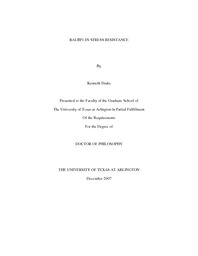
ATTENTION: The works hosted here are being migrated to a new repository that will consolidate resources, improve discoverability, and better show UTA's research impact on the global community. We will update authors as the migration progresses. Please see MavMatrix for more information.
Show simple item record
| dc.contributor.author | Drake, Kenneth | en_US |
| dc.date.accessioned | 2008-08-08T02:31:05Z | |
| dc.date.available | 2008-08-08T02:31:05Z | |
| dc.date.issued | 2008-08-08T02:31:05Z | |
| dc.date.submitted | December 2007 | en_US |
| dc.identifier.other | DISS-1996 | en_US |
| dc.identifier.uri | http://hdl.handle.net/10106/912 | |
| dc.description.abstract | Ralbp1 is a multi-specific transporter of glutathione conjugates as well as unconjugated amphiphilic toxins. Because glutathione conjugates are major metabolites of toxic lipid peroxidation products generated as a consequence of oxidant and radiant stress, the hypothesis is put forth that the function of Ralbp1 in-vivo and in vitro should be to protect organisms from chemical stress by removing toxic chemicals. Studies described in this dissertation were designed to prove this hypothesis. We tested the hypothesis by examining whether the inhibition or augmentation of Ralbp1 would sensitize or protect cells and whole animals from the toxic effects of chemicals and radiation. These studies establish that Ralbp1 is a primary determinant of resistance to chemical stressors by the direct transport of these toxins. | en_US |
| dc.description.sponsorship | Awasthi, Sanjay | en_US |
| dc.language.iso | EN | en_US |
| dc.publisher | Chemistry & Biochemistry | en_US |
| dc.title | Ralbp1 In Stress Resistance | en_US |
| dc.type | Ph.D. | en_US |
| dc.contributor.committeeChair | Awasthi, Sanjay | en_US |
| dc.degree.department | Chemistry & Biochemistry | en_US |
| dc.degree.discipline | Chemistry & Biochemistry | en_US |
| dc.degree.grantor | University of Texas at Arlington | en_US |
| dc.degree.level | doctoral | en_US |
| dc.degree.name | Ph.D. | en_US |
Files in this item
- Name:
- umi-uta-1996.pdf
- Size:
- 1.224Mb
- Format:
- PDF
This item appears in the following Collection(s)
Show simple item record


